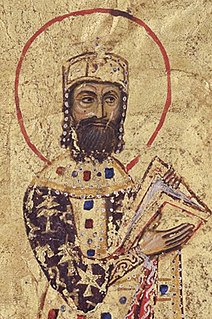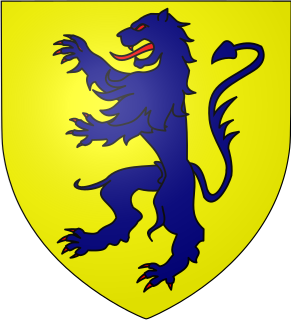Related Research Articles

Year 1081 (MLXXXI) was a common year starting on Friday of the Julian calendar.
Owain ap Gruffudd was King of Gwynedd, North Wales, from 1137 until his death in 1170, succeeding his father Gruffudd ap Cynan. He was called Owain the Great and the first to be styled "Prince of Wales". He is considered to be the most successful of all the North Welsh princes prior to his grandson, Llywelyn the Great. He became known as Owain Gwynedd to distinguish him from the contemporary king of Powys Wenwynwyn, Owain ap Gruffydd ap Maredudd, who became known as Owain Cyfeiliog.
Gruffydd ap Llywelyn was the King of Wales and had repeatedly defeated the English forces. He was the son of King Llywelyn ap Seisyll and Angharad, daughter of Maredudd ab Owain. He was the great-great-grandson of Hywel Dda.

Gruffudd ap Cynan, sometimes written as Gruffydd ap Cynan, was King of Gwynedd from 1081 until his death in 1137. In the course of a long and eventful life, he became a key figure in Welsh resistance to Norman rule, and was remembered as King of all Wales. As a descendant of Rhodri Mawr, Gruffudd ap Cynan was a senior member of the princely House of Aberffraw.

The Kingdom of Powys was a Welsh successor state, petty kingdom and principality that emerged during the Middle Ages following the end of Roman rule in Britain. It very roughly covered the northern two-thirds of the modern county of Powys and part of today's English West Midlands. More precisely, and based on the Romano-British tribal lands of the Ordovices in the west and the Cornovii in the east, its boundaries originally extended from the Cambrian Mountains in the west to include the modern West Midlands region of England in the east. The fertile river valleys of the Severn and Tern are found here, and this region is referred to in later Welsh literature as "the Paradise of Powys".

Rhys ap Tewdwr was a king of Deheubarth in Wales and member of the Dinefwr dynasty, a branch descended from Rhodri the Great. He was born in the area which is now Carmarthenshire and died at the battle of Brecon in April 1093.
Gruffydd ap Rhys was Prince of Deheubarth, in Wales. His sister was the Princess Nest ferch Rhys. He was the father of Rhys ap Gruffydd, known as 'The Lord Rhys', who was one of the most successful rulers of Deheubarth during this period.
Gwenllian ferch Gruffydd was Princess consort of Deheubarth in Wales, and married to Gruffydd ap Rhys, Prince of Deheubarth. Gwenllian was the daughter of Gruffudd ap Cynan (1055–1137), Prince of Gwynedd and Angharad ferch Owain, and a member of the princely Aberffraw family of Gwynedd. Gwenllian's "patriotic revolt" and subsequent death in battle at Kidwelly Castle contributed to the Great Revolt of 1136.
Trahaearn ap Caradog was a King of Gwynedd. Trahaearn was a son of Caradog ap Gwyn, ruler of Arwystli, a small state, on the south-western border between Gwynedd and Powys. He was born in 1044 in Arwystli, and died in 1081 in Mynydd Carn in Pembrokeshire, at the Battle of Mynydd Carn.
Bleddyn ap Cynfyn, sometimes spelled Blethyn, was an 11th-century Welsh king. Harold Godwinson and Tostig Godwinson installed him and his brother, Rhiwallon, as the co-rulers of Gwynedd on his father's death in 1063, during their destruction of the kingdom of Bleddyn's half-brother, Gruffydd ap Llywelyn. He became king of Powys and co-ruler of the Kingdom of Powys with his brother Rhiwallon from 1063 to 1075. His descendants continued to rule Powys as the House of Mathrafal.
Caradog ap Gruffydd was a Prince of Gwent in south-east Wales in the time of Gruffydd ap Llywelyn and the Norman conquest, who reunified his family's inheritance of Morgannwg and made repeated attempts to reunite southern Wales by claiming the inheritance of the Kingdom of Deheubarth.
Robert of Rhuddlan was a Norman adventurer who became lord of much of north-east Wales and for a period lord of all North Wales.

Cadwgan ap Bleddyn (1051–1111) was a prince of the Kingdom of Powys in north eastern Wales.

Brycheiniog was an independent kingdom in South Wales in the Early Middle Ages. It often acted as a buffer state between England to the east and the south Welsh kingdom of Deheubarth to the west. It was conquered and pacified by the Normans between 1088 and 1095, though it remained Welsh in character. It was transformed into the Lordship of Brecknock and later formed the southern and larger part of the historic county of Brecknockshire. To its south was the Kingdom of Morgannwg.

Gwent was a medieval Welsh kingdom, lying between the Rivers Wye and Usk. It existed from the end of Roman rule in Britain in about the 5th century until the Norman conquest of England in the 11th century. Along with its neighbour Glywyssing, it seems to have had a great deal of cultural continuity with the earlier Silures, keeping their own courts and diocese separate from the rest of Wales until their conquest by Gruffydd ap Llywelyn. Although it recovered its independence after his death in 1063, Gwent was the first of the Welsh kingdoms to be overrun following the Norman conquest.
This article is about the particular significance of the century 1101–1200 to Wales and its people.
This article is about the particular significance of the century 1001–1100 to Wales and its people.

Wales in the Middle Ages covers the history of the country that is now called Wales, from the departure of the Romans in the early fifth century, until the annexation of Wales into the Kingdom of England in the early sixteenth century.

The history of Gwynedd in the High Middle Ages is a period in the History of Wales spanning the 11th through the 13th centuries. Gwynedd, located in the north of Wales, eventually became the most dominant of Welsh kingdoms during this period. Distinctive achievements in Gwynedd include further development of Medieval Welsh literature, particularly poets known as the Beirdd y Tywysogion associated with the court of Gwynedd; the reformation of bardic schools; and the continued development of Cyfraith Hywel. All three of these further contributed to the development of a Welsh national identity in the face of Anglo-Norman encroachment of Wales.
References
- ↑ Paul Russell (ed) (2006). Vita Griffini Filii Conani: The Medieval Latin Life of Gruffudd Ap Cynan. University of Wales Press. ISBN 0-7083-1893-2
- 1 2 The Welsh Academy Encyclopaedia of Wales
- 1 2 A history of Wales from the earliest times